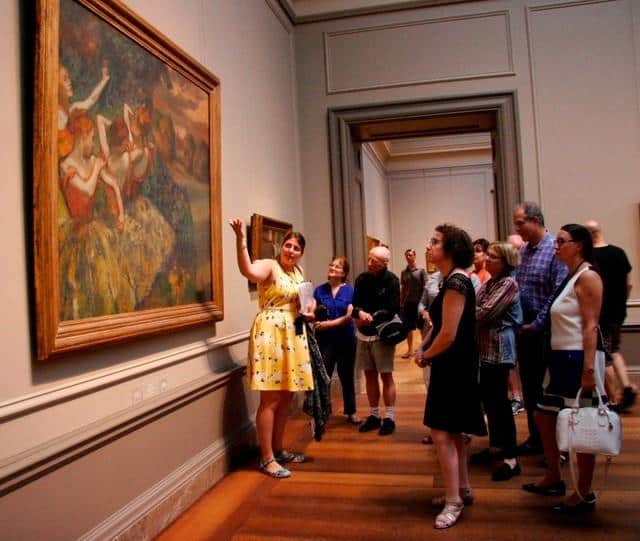The phrase “adventure tour” likely brings to mind pulse-quickening activities like extreme sports. But Diane Maglaque, owner of the Washington, D.C.-area based tour operator Adventures for Creative Tourists, has something different in mind when it comes to the word adventure. “I wanted to convey to people that you can have an adventure in a museum,” she says. “You don’t have to go rappelling off a cliff or anything like that!”

Going on a walking tour of an art museum allows visitors to consider questions about themselves and others. “When you’re looking at art, you’re looking at it as an individual and as a group,” Maglaque says. “Individually, you come to an art piece asking questions like, ‘How does this make me feel? What’s the story behind this? Is it trying to teach something?’ Then you can talk about art with others. It’s a conversation starter.”
One key to her company’s success has been finding engaging, passionate tour guides to lead groups through the museums and city streets. Here’s how she finds, vets and hires dynamic guides that enable traveling creatives (and people who don’t get the opportunity to be creative very often!) to participate in immersive, enriching experiences.
A Business License Matters
When Maglaque looks to add guides for the eight tours she’s currently offering—including those in the National Gallery of Art and the Library of Congress—it’s essential that tour guides have a business license. “Unfortunately, a lot of people don’t bother getting one,” she says. “But I look for it. It means that they’re willing to pay the D.C. government to get licensed, they’re dedicated.”
Engage Local Guilds and DMCs
While searching for qualified tour guides online is a valid option (Maglaque found one of her guides on Indeed.com), guilds can also be helpful in connecting you with the right people. “I’m connected with the Guild of Professional Tour Guides in D.C.,” she notes. “I go to their job fairs, and I also know some of the companies that train tour guides in our area.”
While she admits it can be difficult to find reliable guides, she’s also found that lists of tour guides from D.C.’s destination management companies (DMCs) can be useful. “You have to get to know those companies,” she says. “Start asking questions. People will tell you which ones are good and which ones aren’t.”
Recommendations, Certifications and Interests
Asking tour guides you currently work with to recommend friends and colleagues can lead to positive results, as Maglaque found when she began working with a tour guide based on an endorsement. It also helps for guides to have deep knowledge about the tour’s subject in order to successfully educate others about it. Maglaque doesn’t just look for a prospect’s experience working for other tour companies. “I look for relevance on their resume that tells me that they love art and street art, in addition to experience with different companies,” she notes. Certifications can also be a good sign. “I getting a lot of certifications, and adding more,” Maglaque explains. “And that they’re doing other types of tours. They’re a renaissance tour guide!”
Great Storytellers
When Maglaque finds a tour guide she believes could work for her regularly, she attends their first tour. “I want to see how they interact with a group of people, not just me,” she explains. “Are they paying attention to the lady walking slowly in the back? Or seems to not be able to hear?” The ideal tour guide can also spin quite a yarn. “It’s a bit of a theater show!” she says. “I need someone who can talk, who has a big personality and can tell a story. They have the ability to get all eyes on them, and make sure everyone’s following along and not falling asleep. And they know a lot of facts, but can retell them in a creative way.”
Maglaque passes along negative customer feedback to her guides to help them enhance the tour. “I’m honest with them,” she explains. “A good tour guide will say, ‘I see someone wasn’t happy, and I need to punch it up.’ And they’ll think about their tour—if they need to bring more elements into it, they’ll do it. The tour guides that can’t do not last.” And because a museum’s art collection is often being loaned out, and street art murals can disappear overnight, flexibility is key. “They’re constantly shifting the tours,” she says. She’ll also encourage guides to leave out art they don’t like, and to focus on their passions. “They have so many different art pieces in a room that if someone knows a lot about one piece, talk about it,” she notes. “That’s your piece you want to talk about!”
Overall, an excellent tour guide isn’t satisfied with the status quo. “The really good tour guides are constantly learning,” she says. “And they’re not just learning about art. They’re learning about the city, about destinations.”

















